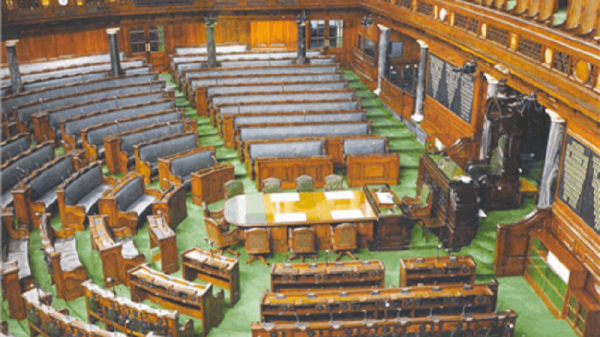For a long time, the metaverse has been the stuff of science fiction. But leaders of big tech corporations say not anymore.
“Since the late 1970s and early 1980s, many of those in the technology community have imagined a future state of, if not quasi-successor to, the Internet – called the Metaverse,” venture capitalist Matthew Ball wrote in his highly influential piece on this subject. But what is this metaverse, what sort of experiences does it provide, and when will it be ready are some of the questions many have.
“The Metaverse has become the newest macro-goal for many of the world’s tech giants,” Ball wrote in his January 2020 piece. Since then a lot has happened in this space. Most recently, Mark Zuckerberg told The Verge in an interview that the future of Facebook is building the metaverse, and a few days later the social media giant set up a separate project group for this endeavor. The metaverse is no longer the stuff of science fiction, it is real and it is happening. Hence, it’s time we start learning what it’s all about.
What is the metaverse?
The metaverse is many things, but one thing it is not: easy to explain. But, by the end of this post, you will walk away with a much better idea of what the metaverse is, even though you might not be able to explain the same to someone else.
History of the term: The term metaverse was first coined in Neal Stephenson’s 1992 science fiction novel Snow Crash in which avatars of humans interact with each other and software agents in a 3D space that uses the metaphor of the real world.
Definition: Wikipedia defines it as “a collective virtual shared space, created by the convergence of virtually enhanced physical reality and physically persistent virtual space, including the sum of all virtual worlds, augmented reality, and the internet.” If that is a mouthful, don’t fret, we will walk you through it.
So, it’s virtual reality? Nope. “I think a lot of people when they think about the metaverse, they think about just virtual reality. But the metaverse isn’t just virtual reality. It’s going to be accessible across all of our different computing platforms; VR and AR, but also PC, and also mobile devices and game consoles,” Zuckerberg says. “VR is a way to experience a virtual world or space. Sense of presence in a digital world doesn’t make a Metaverse,” Ball adds.
Fortnite-style games then? No again. “I think entertainment is clearly going to be a big part of it, but I don’t think that this is just gaming,” Zuckerberg said. “While the Metaverse may have some game-like goals, include games, and involve gamification, it is not itself a game, nor is it oriented around specific objectives,” Ball says.
Second Life maybe? “Digital content experiences like Second Life are often seen as “proto-Metaverses” because they (A) lack game-like goals or skill systems; (B) are virtual hangouts that persist; (C) offer nearly synchronous content updates; and (D) have real humans represented by digital avatars. However, these are not sufficient attributes for the Metaverse,” Ball explains.
Okay, I got it. Ready Player One. Close but not quite there. “The most common conceptions of the Metaverse stem from science fiction. Here, the Metaverse is typically portrayed as a sort of digital ‘jacked-in’ internet – a manifestation of actual reality, but one based in a virtual (often theme park-like) world. While these sorts of experience are likely to be an aspect of the Metaverse, this conception is limited,” Ball explains.
An immersive internet? “You can think about the metaverse as an embodied internet, where instead of just viewing content — you are in it,” Zuckerberg says. “I think that this is a persistent, synchronous environment where we can be together, which I think is probably going to resemble some kind of a hybrid between the social platforms that we see today, but an environment where you’re embodied in it,” Zuckerberg added. But metaverse “is not just another YouTube or Facebook-like platform in which countless individuals can ‘create’, ‘share’, and ‘monetize’ content,” Ball says.
I give up: Here you go. The most comprehensive explanation of what the metaverse is, as laid out by Matthew Ball:
- Persistent – The metaverse doesn’t pause or reset as games do, it continues indefinitely.
- Synchronous and live – The metaverse will be a real-time experience that exists consistently for everyone, but just as in real life, it will include pre-scheduled and self-contained events.
- No cap to concurrent users – The metaverse will allow everyone to be a part of it and participate in an activity at the same time with individual agency.
- Full functioning economy – The metaverse will allow individuals and businesses to create, sell, and be rewarded for a wide range of work that is of value to others.
- Spans multiple realms – The metaverse experience is not limited to digital, it will span both the digital and physical worlds, private and public experiences, and open and closed platforms.
- Offer unprecedented interoperability – The metaverse will allow interoperability of all data, digital assets, content, etc. “Your ‘Counter-Strike’ gun skin, for example, could also be used to decorate a gun in Fortnite, or be gifted to a friend on/through Facebook,” Ball said.
- Wide range of contributors – The metaverse will be populated by content and experiences created and operated by a wide range of contributors who may be independent individuals or big companies.
Is there a simpler explanation? “You can imagine it as the Nightmare Before Christmas – you can walk into any experience or activity, and potentially address almost any of your needs, from a single starting point or world that’s also populated by everyone else you know,” Ball explains. “But what’s important is to recognize the Metaverse isn’t a game, a piece of hardware, or an online experience. This is like saying ‘World of Warcraft’, the iPhone, or Google is the Internet. They are digital worlds, devices, services, websites, etc. The Internet is a wide set of protocols, technology, tubes, and languages, plus access devices and content and communication experiences atop them. Metaverse will be too,” Ball adds.
What kinds of experiences are possible in the metaverse?
If you are still confused about what a metaverse is, here are some interesting experiences that the metaverse will make possible that will help you relate to this concept much more easily. But remember, this is a very (very) small subset of what is possible in the metaverse.
Teleportation-like experience: “If you want to talk to someone, you’re working through a problem, instead of just calling them on the phone, they can teleport in, and then they can see all the context that you have. They can see your five monitors, or whatever it is, and the documents or all the windows of code that you have, or a 3D model that you’re working on. And they can stand next to you and interact, and then in a blink they can teleport back to where they were and kind of be in a separate place,” Zuckerberg says.
A portable workstation: Another example that Zuckerberg gives: “So, one is you will be able to, with basically a snap of your fingers, pull up your perfect workstation. So anywhere you go, you can walk into a Starbucks, you can sit down, you can be drinking your coffee and kind of wave your hands and you can have basically as many monitors as you want, all set up, whatever size you want them to be, all preconfigured to the way you had it when you were at your home before. And you can just bring that with you wherever you want.”
Realistic fitness experiences but from any place any time: “These apps like Supernatural and FitXR, which you can kind of think about it like Peloton, but instead of having a bike or a treadmill, the device is your VR headset and you’re basically taking a class in there, where you’re boxing or dancing. And it’s really fun,” Zuckerberg says.
Who will own or run the metaverse?
No one company: “Critically, no one company will run the metaverse,” Zuckerberg says.”It will be operated by many different players in a decentralized way.”
“I don’t think in the future, people are going to call the work that individual companies do a metaverse. Hopefully, if we’re successful collectively in building a system that’s more interoperable, and where you can teleport between things, it should all be the metaverse, each company should not have its own metaverse. Hopefully in the future, asking if a company is building a metaverse will sound as ridiculous as asking a company how their internet is going.” – Zuckerberg
Will have a sense of interoperability and portability: “You have your avatar and your digital goods, and you want to be able to teleport anywhere. You don’t want to just be stuck within one company’s stuff. […] The software that we [Facebook] build, for people to work in or hang out in and build these different worlds, that’s going to go across anything. So other companies build out VR or AR platforms, our software will be everywhere. Just like Facebook or Instagram is today,” Zuckerberg explains.
Will have common standards around important protocols: “I do think that, just like you have the W3C that helps set standards around a bunch of the important internet protocols and how people build the web, I think there will need to be some of that here, too, for defining how developers and creators can build experiences that allow someone to take their avatar and their digital goods and their friends, and be able to teleport seamlessly between all these different experiences,” Zuckerberg says.
What kinds of economic opportunities does the metaverse create?
Same diversity of opportunity as we saw with the web: “The Metaverse should produce the same diversity of opportunity as we saw with the web – new companies, products and services will emerge to manage everything from payment processing to identity verification, hiring, ad delivery, content creation, security, and so forth. This, in turn, will mean many present-day incumbents are likely to fall,” Ball says.
New types of work as well: “I do think that there will be entirely new types of work too. So in terms of designing places where people hang out, this is going to be a massive part of the creator economy, I think. You’ll have individual creators designing experiences and places. You’ll have artists doing things. You’d get concerts in there. You have this whole set of creators who are building out different experiences, ranging from an individual creator to teams of dozens of people. So I think that there’s going to be a whole economy around this,” Zuckerberg says
Even more economic upside than the internet: “The value of being a key participant, if not a driver, of such a system is self-evident – there is no ‘owner’ of the Internet today, but nearly all of the leading Internet companies rank among the 10 most valuable public companies on earth. And if the Metaverse does indeed serve as a functional ‘successor’ to the web — only this time with even greater reach, time spent, and more commercial activity — there’s likely to be even more economic upside,” Ball points out.
When will the metaverse be ready?
Won’t directly come into existence: “The Metaverse will require countless new technologies, protocols, companies, innovations, and discoveries to work. And it won’t directly come into existence; there will be no clean “Before Metaverse” and “After Metaverse”. Instead, it will slowly emerge over time as different products, services, and capabilities integrate and meld together,” Ball explains.
Technology still remains a challenge: “I think to get AR glasses that we wear around throughout the day, they have to be normal-looking glasses, right? So you’re basically cramming all of these materials to build what we would’ve thought of as a supercomputer 10 years ago into the frame of glasses that are about five millimeters thick — you have computer chips, and networking chips, and holographic wave guides, and things for sensing and mapping out the world, and batteries and speakers, all this stuff, and it just needs to fit into these glasses — so that is a real challenge. And I actually would go so far as to say that I think that might be one of, if not the biggest technological challenge that our industry will face in the next decade,” Zuckerberg says.
Core elements that need to be ready: Matthew Ball identifies the following core elements that need to come into place for the metaverse to exist:
- Concurrency infrastructure: “The technology simply does not yet exist for there to be hundreds, let alone millions of people participating in a shared, synchronous experience. […] To operate, the Metaverse requires something more akin to video conferencing and video games. These experiences work because of persistent connections that update each other in real-time and with a degree of accuracy that other programs don’t generally need. However, they tend not to have high levels of concurrency: most video chat programs max out beyond a few people, and once you hit 50, you tend to need to “live stream” a broadcast to your viewers, rather than share a two-way connection,” Ball explains.
- Standards and protocols: “The Internet as we experience it today works because of standards and protocols for visual presentation, file loading, communications, graphics, data, and so forth. The Metaverse will require an even broader, more complex, and resilient set of S&Ps. […] This will be enormously difficult and take decades,” Ball says.
- The experience on the platform: “Just as the standards for the Metaverse can’t simply be ‘declared’, consumers and businesses won’t embrace a would-be proto-Metaverse simply because it’s available. Consider the real world. Just making a mall capable of fitting a hundred thousand people or a hundred shops doesn’t mean it attracts a single consumer or brand. Ultimately, any place of congregation — be it a bar, basement, park, museum or merry go-round — is attended because of who or what is already there, not because it’s a place in of itself. As with Facebook, the Metaverse needs to be ‘populated’, rather than just ‘populable’, and this population must then fill in this digital world with things to do and content to consume. […] Fortnite began as a game, but it quickly evolved into a social square. Its players aren’t logging in to “play”, per se, but to be with their virtual and real-world friends. Teenagers in the 1970s to 2010s would come home and spend three hours talking on the phone. Now they talk to their friends on Fortnite, but not about Fortnite. Instead, they talk about school, movies, sports, news, boys, girls and more,” Ball says.
Some Other Challenges
- Different companies will have different visions: “I don’t think every company is going to have exactly the same vision here. I think some are going to have more siloed visions, and I, at least, believe that in order for this to work really well, you want it to be very portable and interconnected,” Zuckerberg says.
- Agreement on standards and protocols: “The more valuable and interoperable the Metaverse is, the harder it will be to establish industry-wide consensus around topics such as data security, data persistence, forward-compatible code evolution, and transactions,” Ball says.
- Gender skew: “One of the big issues that I think people need to think through is right now there’s a pretty meaningful gender skew, at least in virtual reality, where there’s a lot more men than women. And in some cases that leads to harassment. […] You’re not going to have a healthy and vibrant community if it skews so much towards one gender or the other, or a whole part of the population just doesn’t feel safe,” Zuckerberg says.
How will this space be regulated?
Well, we are still yet to figure out how to regulate the current internet but the metaverse, “will need altogether new rules for censorship, control of communications, regulatory enforcement, tax reporting, the prevention of online radicalization, and many more challenges,” Ball points out.
“A thriving metaverse would raise questions both familiar and strange about how the virtual space is governed, how its contents would be moderated, and what its existence would do to our shared sense of reality. We’re still getting our arms wrapped around the two-dimensional version of social platforms; wrangling the 3D version could be exponentially harder,” Casey Newton writes for The Verge.
Metaverse Reading List
- The Metaverse: What It Is, Where to Find it, Who Will Build It, and Fortnite by Matthew Ball
- Mark In the Metaverse by The Verge
- Matthew Ball’s nine-part primer on the metaverse
- Are We in the Metaverse Yet? by New York Times
- Tim Sweeney: The open metaverse requires companies to have enlightened self-interest
- Nvidia CEO Jensen Huang weighs in on the metaverse, blockchain, and chip shortage
- The Metaverse Is Coming And It’s A Very Big Deal by Forbes
Have something to add? Subscribe to MediaNama and post your comment
























You must be logged in to post a comment Login